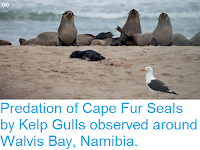The Allodesmines are an extinct group of Pinnipeds thought to have been closely related to the True Seals, which are known from the Middle-to-Late Miocene of Japan and the Pacific Coast of North America. They were large animals, reaching about 2.5 m in length, and showed sexual dimorphism, with males bigger than the females and having enlarged canine teeth, presumed to have been used in combat with one-another over mating rights. The taxonomy of Allodesmines is somewhat controversial, with some palaeontologists claiming as many as eight species in four genera, while others recognise only five species in a single genus, Allodesmus.
In a paper published in the journal Royal Society Open Science on 16 May 2018, Wataru Tonomori of the Graduate School of Life and Environmental Sciences at the University of Tsukuba, Hiroshi Sawamura of the Ashoro Museum of Paleontology, Tamaki Sato of the Department of Astronomy and Earth Sciences at the Tokyo Gakugei University, and Naoki Kohno, also of the Graduate School of Life and Environmental Sciences at the University of Tsukuba, and of the Department of Geology and Paleontology at the National Museum of Nature and Science, describe a new species of Allodesmine Seal from the middle Miocene Atsunai Formation of Urahoro, on Hokkaido Island, Japan.
The new species is placed in the genus Allodesmus (Tonomori et al. recognise two genera of Allodesmines, Atopotarus), and given the specific name uraiporensis, meaning 'from Urahoro' (Uraiporo is an old form of Urahoro, itself meaning 'place where big Fish gather' in the Ainu language. The species is described from a single disarticulated but largely complete male specimen, differentiated from all other members of genus by its dentition and structure of the skull.
Reconstruction of Allodesmus uraiporensis skeleton. Blue parts indicate preserved bones. Tonomori et al. (2018).
With an estimated age of between 16.3 and 13.5 million years old, Allodesmus uraiporensis, is the oldest known member of the genus from the West Pacific, and may represent the earliest arrival of the genus on this side of the ocean, during the Miocene Climatic Optimum (a period of warmth and stability lasting from about 18.0 million years ago till about 14.8 million years ago), which then resulted in an adaptive radiation in the West Pacific, which resulted in several new species.
See also...
Follow Sciency Thoughts on Facebook.





